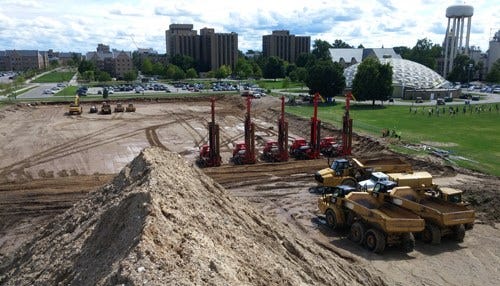Notre Dame’s First Geothermal Field Up and Running
 (Image courtesy of the University of Notre Dame)
(Image courtesy of the University of Notre Dame)
Subscriber Benefit
As a subscriber you can listen to articles at work, in the car, or while you work out. Subscribe NowThe University of Notre Dame (UND) has been working for some time to reduce its carbon footprint, but in 2015 school leaders announced UND would stop burning coal within five years and drop that carbon footprint by more than half by 2030. A significant step came this summer when the campus’s first geothermal field went online.
Notre Dame operates its own power plant to provide heating and cooling for the campus and co-generates about half its electrical usage. Historically the plant has been coal-fired, but Paul Kempf, senior director of utilities and maintenance at UND, says that 2020 deadline is real.
“We’re migrating toward that target to cease combustion of coal. We’ll rely more heavily on natural gas, but we’re also starting to integrate some renewable or recoverable energy projects as well. There are a lot of options and we think it’s a good idea to diversify our energy portfolio, not knowing what the best answer might be.”
With encouragement from Pope Francis urging good stewardship to reduce climate change, the quest for the university to reduce carbon emissions by 50 percent by 2030 (from its 2005 baseline) is a near goal. Looking further ahead, the goal is an 83 percent reduction by 2050. It’s based on an adjusted square foot basis, as the campus is expected to continue to change over the ensuing decades. That’s one area where the geothermal fields come in.
Notre Dame has installed three geothermal fields. The first was a 300 ton well field on the east campus and was put into use this summer. It serves two existing buildings, the Ricci Band Building and Pasquerilla Center, as their primary source for heating and cooling. Kempf says another small building could be added to the system in the future, or the field itself could be expanded. Right now it does its work quietly beneath youth soccer fields.
Geothermal fields use the near-constant temperature of the earth’s crust, about 55 degrees, to reduce the energy it takes to heat or cool air. Kempf says it’s optimal for use in Indiana, where summers can be hot and winters very cold. The earth’s consistent temperature can be used to cool hot air and warm cold air more efficiently.
“If you had a coil, such as a garden hose, and you ran cold water through it, and you blow a fan across it, and you stand on the other side, the air coming out’s going to be cooler because you’re running hot air across a cold coil. And you can do the reverse, you can blow cold air across a warm coil and you will feel heat.”
The other two geothermal fields are located below the parking lot just south of Notre Dame Stadium and under the athletic and marching band practice fields near Stepan Center. Plans are for them to go into operation in 2018 and 2019.
“The well fields were all put in ahead of time, so if you came to a football game, you’d park on top of it, you don’t even know it’s there. Or the kids are out here playing on these brand new rec fields. We took advantage of timing to get the wells in and the piping pointed where we knew we wanted to go longer term, as projects develop, we’ll tie them in,” explains Kempf. “So when we get done, we’ll have 2650 tons of geothermal system on campus with these three projects. About 20 percent of our capacity will be geothermal.”
Kempf estimates the pay-back on the investment will be in the 15-to-20 year range, especially as energy costs fluctuate in the long term. He says while carbon offsets could be purchased, that’s not the direction the university wanted to go.
“We’re not doing it because we’re trying to save a lot of money. These small projects, like geothermal and solar, are scaling our way up in terms of reducing our carbon footprint. Our strategy also is just an opportunity at an educational institution to demonstrate technology for our students, our faculty and the general public."
Paul Kempf explains that geothermal is a closed-loop system.
